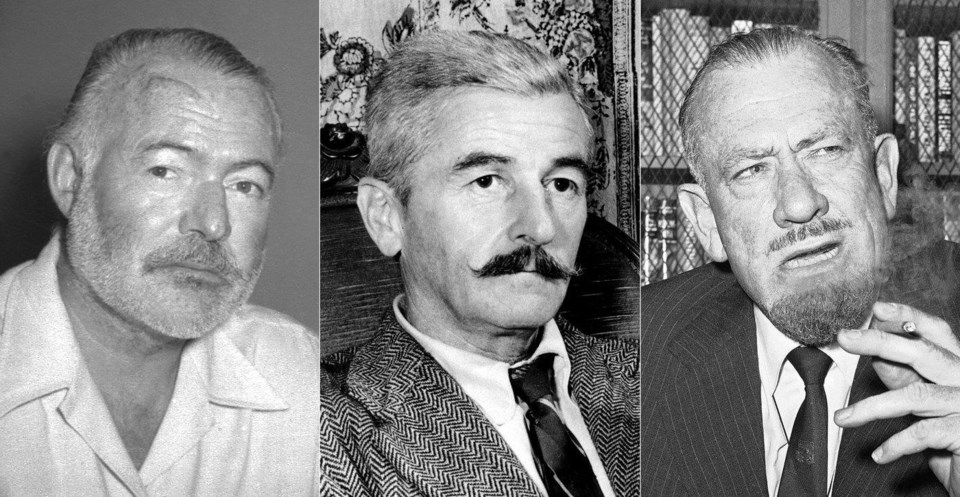Popeye can punch without permission and can roam freely starting in 2025. The two classic comic characters who first appeared in 1929 are among the intellectual properties becoming in the United States on Jan. 1. That means they can be used and repurposed without permission or payment to copyright holders.
This year’s crop of newly public artistic creations lacks the landmark vibes of last year’s entrance of . But they include a deep well of canonical works whose 95-year copyright maximums will expire. And the Disney icon's public domain presence expands.
“It’s a trove! There are a dozen new Mickey cartoons — he speaks for the first time and dons the familiar white gloves,” said Jennifer Jenkins, director of . “There are masterpieces from Faulkner and Hemingway, the first sound films from Alfred Hitchcock, Cecil B. DeMille, and John Ford, and amazing music from Fats Waller, Cole Porter, and George Gershwin. Pretty exciting!”
Here’s a closer look at this year’s crop.
Comics characters loom large
Popeye the Sailor, with his bulging forearms, mealy-mouthed speech, and propensity for fistfights, was created by E.C. Segar and made his first appearance in the newspaper strip “Thimble Theater” in 1929, speaking his first words, “’Ja think I’m a cowboy?” when asked if he was a sailor. What was supposed to be a one-off appearance became permanent, and the strip would be renamed ”Popeye.”
But as with last year and in 2022, only the earliest version is free for reuse. The spinach that gave the sailor his super-strength was not there from the start, and is the kind of character element that could spawn legal disputes. And the animated shorts featuring his distinctive mumbly voice didn’t begin until 1933 and remain under copyright. As does director Robert Altman’s 1980 film, starring as Popeye and as his oft-fought-over sweetheart Olive Oyl.
That movie was tepidly received initially. So was director “Adventures of Tintin” in 2011. But the comics about the boy reporter that inspired it, the creation of Belgian artist Hergé, were among the most popular in Europe for much of the 20th century.
The simply drawn teen with dots for eyes and bangs like an ocean wave first appeared in a supplement to the Belgian newspaper Le Vingtième Siècle, and became a weekly feature.
The comic also first appeared in the U.S. in 1929. Its signature bright colors — including — didn’t appear until years later, and could, like Popeye’s spinach, be the subject of legal disputes.
And in much of the world, Tintin won’t become public property until 70 years after the 1983 death of his creator.
Books show American lit at its height
The books becoming public this year read like the syllabus for an American literature seminar.
“The Sound and the Fury,” arguably quintessential novel with its modernist stream-of-consciousness style, was a sensation after its publication despite being famously difficult for readers. It uses multiple non-linear narratives to tell the story of a prominent family’s ruin in the author’s native Mississippi, and would help lead to Faulkner’s Nobel Prize.
And “A Farewell to Arms” joins his earlier in the public domain. The partly autobiographical story of an ambulance driver in Italy during the First World War cemented Hemingway’s status in the American literary canon. It has been frequently adapted for film, TV and radio, which can now be done without permission.
first novel, “A Cup of Gold,” from 1929, will also enter the public domain.
The British novelist Virginia Woolf’s “A Room of One’s Own,” an extended essay that would become a landmark in feminism from the modernist literary luminary, is also on the list. Her novel “Mrs. Dalloway” is already in the U.S. public domain.
Movie legends in the making
While a host of truly major movies will become public in the coming decade, for now early works by major figures from the not-always-stellar early sound era will have to suffice.
A decade before he would move to Hollywood and make films like “Psycho,” and “Vertigo,” Alfred Hitchcock made “Blackmail” in Britain. The film was begun as a silent but shifted to sound during production, resulting in two different versions, one of them the UK’s — and Hitchcock’s — first sound film.
John Ford, whose later Westerns would put him among film’s most vaunted directors, also made his first foray into sound with 1929’s “The Black Watch,” an adventure epic that includes Ford’s future chief collaborator John Wayne as a young extra.
Cecil B. DeMille, already a Hollywood bigwig through silents, made his first talkie with the melodrama “Dynamite.”
Groucho, Harpo and the other Marx Brothers had their first starring movie roles in 1929’s “The Cocoanuts,” a forerunner to future classics like “Animal Crackers” and “Duck Soup.”
“The Broadway Melody,” the first sound film and the second film ever to win the Oscar for best picture — known as “outstanding production” at the time — will also become public, though it’s often ranked among the worst of best picture winners.
And after “Steamboat Willie” made the earliest Mickey Mouse public, a dozen more of his animations will get the same status, including “The Karnival Kid,” where he spoke for the first time.
Music rings out the 20s
Songs from the last year of the Roaring Twenties are also about to become public property.
Cole Porter’s compositions “What Is This Thing Called Love?” and “Tiptoe Through the Tulips” are among the highlights, as is the jazz classic “Ain’t Misbehavin’, written by Fats Waller and Harry Brooks.
“Singin’ in the Rain,” which would later forever be associated with the 1952 Gene Kelly film, made its debut in the 1929 movie “The Hollywood Revue” and will now be public domain.
Different laws regulate sound recordings, and those newly in the public domain date to 1924. They include a recording of “Nobody Knows the Trouble I’ve Seen” from future star and civil rights icon Marian Anderson, and “Rhapsody in Blue” performed by its composer George Gershwin.
Andrew Dalton, The Associated Press


